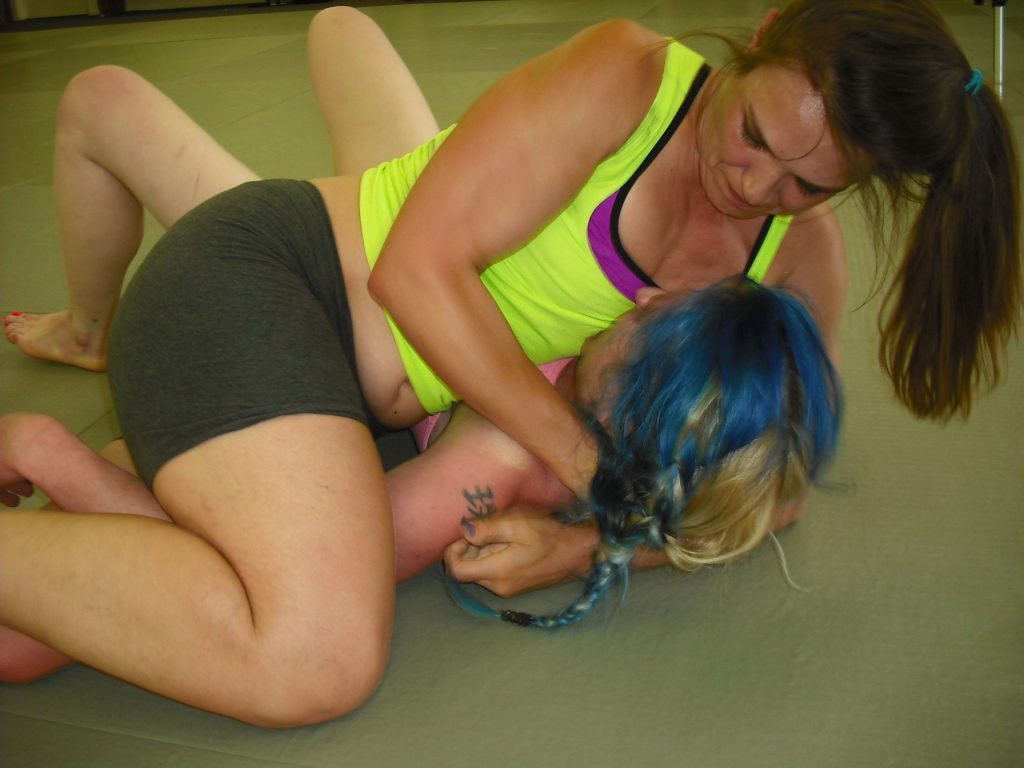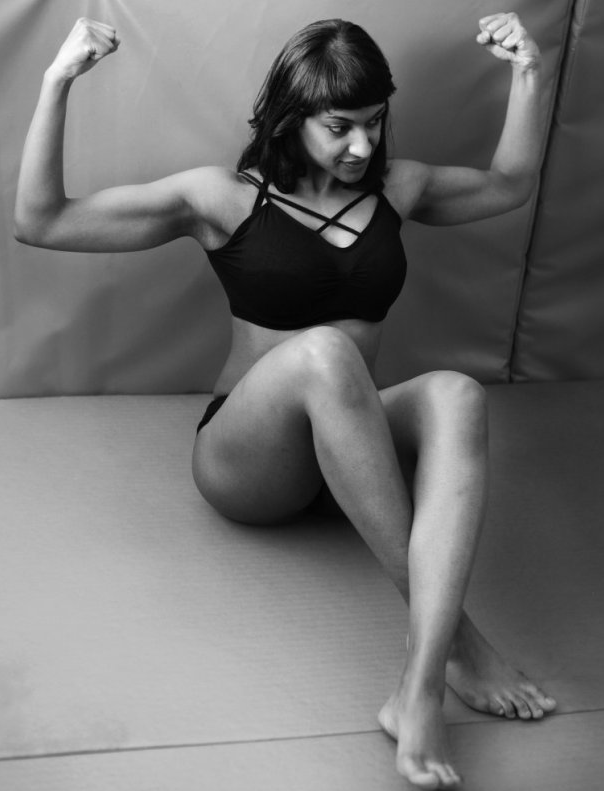
fciwomenswrestling.com femcompetitor.com, fcielitecompetitor.com, pexels.com Andrea-Piacquadio-photo-credit
From the first time that you lay eyes on Northern California’s FeFe, you can’t help but notice her beautiful thighs. How did she develop them?

From riding her bike around her San Francisco Bay Area stomping grounds. We love her so much that one of our writers had a session with her and we wrote an article about her.
FCI Womens Wrestling » FeFe, Submission Wrestler
We’ve also done many video shoots with her.
So female athletes, let’s think about bicycling as part of your fitness routine. If you don’t like to do squats and the heavy weights, riding a bike can do wonders for your thighs.
Justice of the UK loves bike riding and look what it has done for her beautiful thighs.

We fell in love with those gorgeous thighs and wrote about her.
Justice LWS Wrestler, If Loving Her Is Wrong……
As far as bike riding goes, it’s all good.
We have an exceptional guest speaker with some beneficial ideas about including bike riding in your fitness program.
The Benefits of Bicycling – 6 Steps in Turning it Into a Normal Exercise Regimen
The benefits of bicycling for one’s fitness and health are obvious. Any type of normal exercise regimen, followed weekly, is good for an individual’s long-term health. Exercise is beneficial for the human body. Sticking to a dedicated fitness regimen helps an individual improve his/her cardiovascular system and lowers blood pressure within the body. Along with following a diet plan and eating healthy, a routine weekly exercise regimen helps keep off excess weight.
I have been an avid bicyclist for over 30 years. Instead of receiving keys to a car on my 16th birthday, my parents went out and bought me a 10-speed bicycle. I know that 10 speeds for a bicycle nowadays would be considered out-dated. But, please remember this was back in the summer of 1973. Even though I ran track in high school, and would become all-state in short-distant sprints by the time I graduated, I found a love in bicycling.
A few years later while attending college, I would have about five weeks off in between the time that school got out upon the completion of semester finals, and when I would start my job as a summer camp counselor. During that five week period, instead of sitting on the couch daily and watching television for hours at a time, I simply got out my bike and rode around the outskirts of the town that I lived in at the time. My normal route was about 25-30 miles. It involved climbing several hills, but after each workout I felt invigorated.
As I mentioned earlier, I also ran track in high school and later on in college. After graduating, I continued the regimen of running. However, I turned into a distance runner, often hitting the roads for three to four mile workouts. I used to live in New England through my 30’s, and while I still road my bicycle in the summer, it was impossible to do so when several inches of snow were on the streets. So, I did a lot of running as well.
Eventually, all the long distance running that I did for about fifteen years caught up with me. The relentless pounding of my lower body on the pavements on those streets resulted in aching feet and sore knees. I also experienced pain in the Achilles tendon on my right leg. I knew that I had to give up running, which I did, for fear that the Achilles tendon would just snap as a result of the years of stress that I put on it.
I never did give up bicycling however. As a matter of fact, I increased the amount of workouts on my bicycle to maintain a level of physical fitness. That is one of the benefits of bicycling for one’s fitness and health. On a bicycle, your lower joints do not experience the same amount of stress placed on them in comparison to a person running. My feet, knees, and in particular my Achilles tendon do not have anywhere near the same amount of stress placed on them when I was running four times per week. I am now 52 years old. And, several times per week I take my bicycle out and ride it. The only stress that I experience is in climbing the hills which are a part of my workout route. And I feel invigorated upon completion of my exercise regimen.
If you do not participate in a normal exercise regimen and are looking to get back in shape, I suggest that you consider taking up bicycling to fulfill your needs. I have outlined 6 steps, below, in which you can turn bicycling into something which will benefit you health-wise.
1). If you have not invested in any exercise regimen for several years, it is always best to consult first with your doctor or primary-care physician. He/she will set up an exercise routine for you to start out.
2).You might already have an old bicycle that has been in the garage for several years, and is still in working condition. Take it out, bring it to a reputable bicycle repair shop, and let them put in the maintenance work to get it in good running order. Above anything else, you should have a bicycle that is safe to ride on. If you do not own a bicycle; be it a street/road or an off-road mountain bicycle, you can invest in one. It is not necessary for you to invest thousands of dollars into a bicycle. To start off, a two to four hundred dollar investment in a new type of bicycle would be more than adequate.
3). Purchase a good bicycle helmet first before you begin riding. This should be mandatory. I know that I, personally, would not even think about getting on my bicycle without a helmet on my head. A good bicycle helmet would cost about $50-75. Many good helmets come with foam-fitting pad inserts which can be adjusted to fit your head size. I do not ever want anyone to have problems on their bicycle with regards to their safety. But, if an unfortunate incident should occur; injuring a leg, arm, or shoulder would present fewer problems than if something were to happen to a person’s head. Protect your head. If adults have children going out on bicycle rides together, require that the younger ones ride with a helmet as well. As a matter of fact, the adult should role-model for a son or daughter, educationally, that riding with a bicycle helmet is an absolute necessity.
4). Take it slow and easy at first. Feasibly, you could not expect to go out on a ten mile ride, completing the route in under an hour’s time period when you initially begin your bicycling regimen. At first, your body will not allow it. You may experience muscle fatigue upon completion. Actually, you would be smart to stretch your leg muscles as a warm-up before you ride. When you finish, do some more stretching to get rid of the lactic acid which may have built up in your muscles during the ride. Above all, start your regimen with short rides. Ride your bicycle only a couple of times per week, to allow your body to build up both strength and endurance. Remember, Rome was not conquered in one day.
5). Buy yourself a water bottle and as you ride, drink plenty of fluids. Your body loses liquids as you ride through the normal sweating process. You want to keep yourself as hydrated as possible while riding. Drink plenty of fluids after you finish your ride as well to replenish the minerals that you lost while exercising.
6). Remember to follow the rules of the road. Ride as close to the shoulder on a road as possible. I have the luxury, as part of my bicycle route, in riding on a clear, designated bicycle lane, and later a bike/running trail in which no motor vehicles are allowed. This many not be a possibility where you live. I would even consider investing ten dollars on a rear-view mirror to go on either your left handle bar, or one that attaches to your helmet.
Also, wear a bright-colored shirt so that you can be seen by drivers of motor vehicles. Observe all traffic laws, including stopping at traffic signals. Use proper hand signals when you know that you will be making turns in traffic situations.
I used to go on bicycle vacations with a well-known company that specialized in the business. The company’s bicycle tour guides used to teach us the best way to indicate our turn signals, which would enable drivers of vehicles to completely understand our intentions. This was, when making an upcoming left turn; you would point your left arm out straight with the index finger extended outward.
When making a right turn, you perform the same motion with your right arm and right index finger extended outward. Perform these actions well ahead of the time in which you would make the turn. I have heard of other turn signals, which frankly do not notify the driver explicitly of your intentions.
For example: Simply holding your right arm straight up to signify an upcoming right turn. This can be interpreted as being a vague signal to the driver of a vehicle. Does this action mean that you intend to stop? Are you going to turn right? Are you saying hello to the driver, telling him/her that you are aware that he/she is behind you? No, you should make your intentions quite clear by following the above mentioned practice for signaling a turning maneuver by you, the bicyclist.
Any other signal might create confusion for the vehicle driver, and an unfortunate accident involving you the bicyclist.
So, get out there and allow your body to benefit through a normal bicycle exercise regimen.
~ ~ ~
Sources: brainyquote.com, Wikipedia, fciwomenswrestling2.com, FCI Elite Competitor, photos thank you Wikimedia Commons.
Article Source: http://EzineArticles.com/2861531



